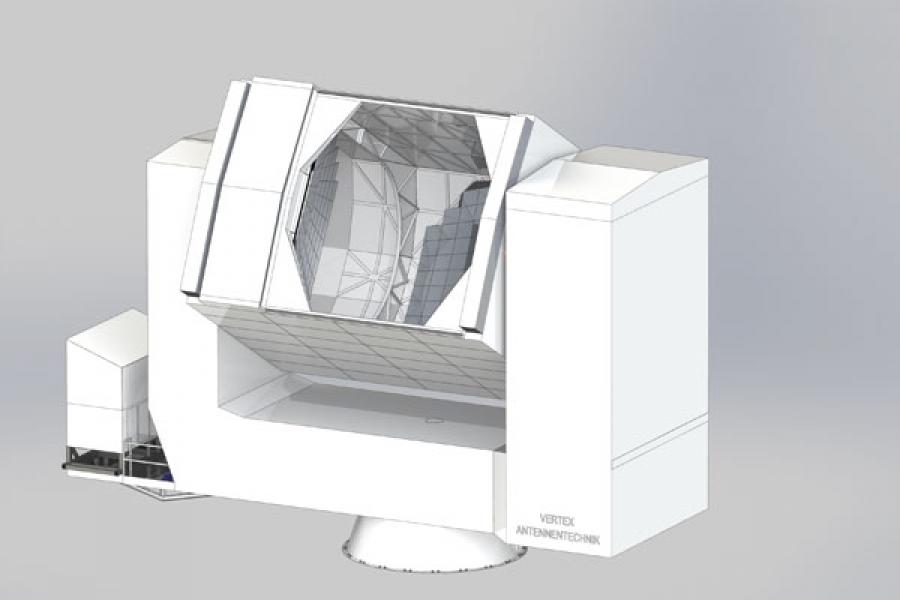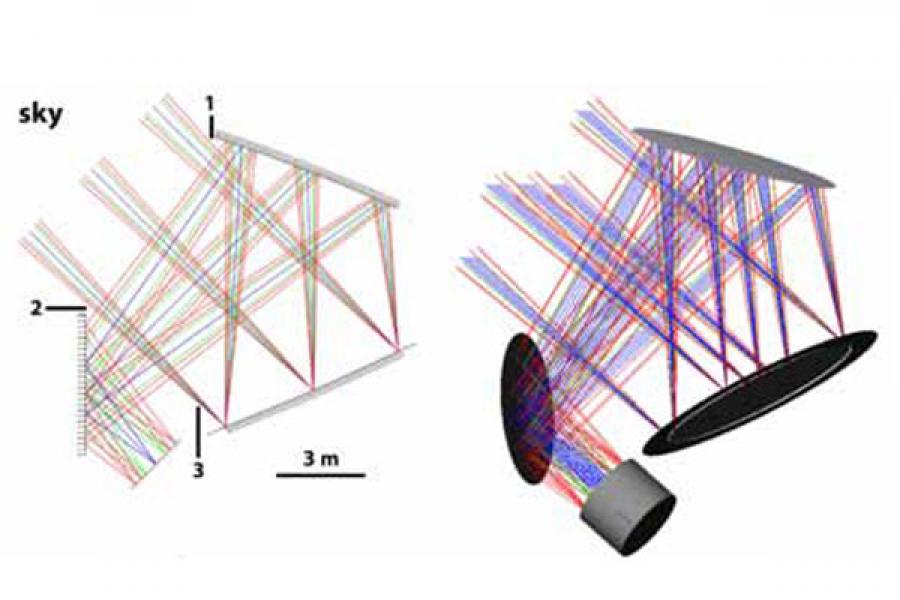Scientists announced this week that a consortium of U.S., German and Canadian academic institutions led by Cornell University will begin construction of Cerro Chajnantor Atacama Telescope-prime (CCAT-p), a unique and powerful telescope capable of mapping the sky at submillimeter and millimeter wavelengths.
The 6 meter aperture telescope, slated for completion in 2021, will be located near the summit of Cerro Chajnantor in the Atacama Desert in Chile. It will give unprecedented insights into how stars and galaxies form, what lit up “cosmic dawn” – the first stars after the Big Bang -- and the formation and dark-energy-driven expansion of the universe. The telescope’s novel optical design, high-precision mirrors and high-altitude location (over 18,000 feet) will establish the CCAT-p telescope as a premiere facility for astrophysics and cosmology research.
“The CCAT partnership has now spent more than a decade exploring the possibility – and challenges – of building a state-of-the-art telescope at this amazing site. During that time, technology and submillimeter science have advanced at a very rapid pace, and we are now ready to move forward to build a truly exciting telescope,” said project director Martha Haynes, Cornell’s Goldwin Smith Professor of Astronomy. “The new telescope will be a game changer for Cornell in the field of cosmology, putting Cornell at the top of the field.”
“It is exciting to see this important project become a reality,” said Cornell Provost Michael Kotlikoff. “Our faculty have long championed the scientific significance of CCAT-prime, and it continues Cornell’s strong legacy of leadership in the field of astronomy.”
Gretchen Ritter, the Harold Tanner Dean of Arts & Sciences, noted that “in addition to being a tremendous asset for research, CCAT-prime will be a boon for career development for young faculty, graduate students and postdocs. We are thrilled at the opportunities CCAT-p will offer our science community.”
CCAT-p is being constructed by Vertex Antennentechnik GmbH of Duisburg, Germany. The CCAT corporation is a partnership of Cornell, the German Universities of Cologne and Bonn, and Canadian Atacama Telescope Consortium (CATC), a consortium of Canadian academic institutions. Faculty and staff at several other institutes in the U.S., Canada, Chile and Germany are also involved in science planning and instrumentation development.
CCAT-p Science
The siting of the telescope at such a high elevation, in such a dry place, will prevent water molecules in the Earth’s atmosphere from impeding the detection of submillimeter radiation, allowing routine observations at these wavelengths. The telescope location and design will also allow observations of about 80 percent of the sky through all seasons.
Its highly efficient mapping capability positions the CCAT-p telescope as a platform for next-generation cosmic microwave background (CMB) experiments. “There has been a lot of excitement in the CMB community about CCAT-prime,” said Michael Niemack, Cornell assistant professor of physics, who designed the telescope optics. “The location appears to be the best-known site on Earth for millimeter and submillimeter wavelengths, and with CCAT-prime we will be able to map the CMB roughly 10 times faster than current telescopes.”
CCAT-prime telescope rendering. Through the large seven meter opening some of the primary mirror panels (right) and secondary mirror panels (left) are visible. Credit: Vertex Antennentechnik GmbH.
The telescope will open the highest frequency radio windows accessible from the ground to study, among other things, the detailed physics of star formation in the Milky Way and the local universe. Jürgen Stutzki of the University of Cologne noted: “The innovative design of the telescope, enabled by the high-tech capabilities of the German company building the telescope and its location at an extreme altitude, enables breathtaking new science blocked at lower altitudes. CCAT-prime will also be an essential platform to deploy new quantum detectors at the cutting edge of physics developed at Cologne, which enable ultra-sensitive observations.”
The innovative telescope design can dramatically improve measurements of polarized signals that may contain “fingerprints” from the time of inflation, a trillionth of a trillionth of a trillionth of a second after the Big Bang. With CCAT-p, scientists will be able to make direct measurements of galaxy cluster motions under the influence of dark matter and dark energy; study how galaxies and galaxy clusters first evolved; and study the properties of neutrinos, some of the lightest known fundamental particles.
At Cornell, the Department of Astronomy is very active in conducting research at submillimeter wavelengths, such as the research groups led by Professor Gordon Stacey and Assistant Professor Dominik Riechers.
"CCAT-p will be a game changer in this forefront area of research, in particular for studies of star formation throughout the history of the universe," said Stacey, who is Lead Project Scientist for CCAT-p.
"Perhaps the most exciting aspect of this project is that it will become possible to probe the evolution of galaxies and the cosmic web all the way back to the Epoch of Reionization within the first billion years after the Big Bang, when stars and galaxies first formed," said Riechers.
The more than 40 researchers from 12 universities across Canada involved with CATC have a wide range of science interests that will be greatly facilitated by CCAT-p, noted Michel Fich, University of Waterloo. “A particular area of interest for the CATC team is in using CCAT-p to investigate the nature of dark matter and dark energy which will lead to advances in our understanding of fundamental physics,” he said.
“CCAT-p science will be an essential complement to the possibilities offered by large observatories like the Atacama Large Millimeter Array (ALMA) in Chile and the Stratospheric Airborne Observatory for Infrared Astronomy (SOFIA),” said Stutzki.
Generous Support
As the founding project director, Riccardo Giovanelli, Cornell professor emeritus of astronomy, noted the success of the project, and Cornell’s leadership, is largely the result of financial support from Fred Young ’64, M.Eng. ’66, MBA ’66. “The project wouldn’t be going forward without Fred’s vision and intellectual passion,” said Giovanelli. In addition to the $5 million Young has contributed toward the development of the CCAT concept, he has committed an additional $7.5 million to CCAT-p.
Fred Young ’64, M.Eng. ’66, MBA ’66
Young said: “CCAT-p is a world-class endeavor which will bring great value to the institutions involved in the forms of both doing important science and attracting quality faculty and students. The fact that Cornell is leading the project is a source of prestige for the university. It, its partners and the greater scientific community will benefit greatly from the CCAT-p work product in the years ahead.
“Given that cosmology, arguably, is the ultimate context for intellectual endeavors, that CCAT-p will contribute to understanding aspects of the very beginning of the universe is an inspirational thought for all involved,” he added.
Young is the retired CEO and former owner of Young Radiator Company. Having served on a number of boards in the private and public sectors and also worked at Daimler-Benz in Germany and Cummins Engine Co. in the U.S., he described his current pursuits as “lifelong learning, limited political involvement and independent investing.” In addition to his sponsorship of academic research in astronomy, he also supports research in economics and great ape conservation.
Science for Students
“One reason that so many important universities are involved in this project is because we want to ensure that the next generation of observers and instrumentalists get hands-on training in a real telescope project,” said Haynes. “CCAT-p will be at the forefront of original science and students will be involved with every aspect, including planning for and execution of the telescope surveys. They won’t just be bolting equipment together -- they will be building instruments and doing everything necessary to prepare for using the telescope.”
Left to right: Jim Blair, Michael Niemack,Riccardo Pavesi, Brian Koopman, Martha Haynes (seated), Gordon Stacey, Thomas Nikola, Dominik Riechers (seated), Eve Vavagiakis, Riccardo Giovanelli (seated), Nicholas Cothard. Credit: Robert Barker/University Photography
Numerous graduate students are already working on technology development related to the project, including preparing the detection devices that will be used in conjunction with the telescope.
Eve Vavagiakis ’14, a physics graduate student in Niemack’s group, worked in astronomy with Stacey as an undergraduate. “CCAT-prime is really going to be at the forefront of the field in a time scale that’s relevant to our careers as grad students,” she said. “It’s exciting to be a part of something that’s going to have such an impact on the field as a whole.”
For Brian Koopman , also a physics graduate student working with Niemack, being in at the start of a project is especially exciting – helping to decide what kind of telescope to build is not a common graduate school opportunity.
“You get to wake up every morning and go in to the lab and try to answer one of the biggest questions human kind has ever asked,” added Vavagiakis. “Being able to study the universe makes me feel lucky every day.”
Telescope Design
Niemack’s research focuses on measuring the Cosmic Microwave Background, leftover light from the Big Bang, the oldest light we can measure. He’s been studying optics since he was a graduate student, and he helped design the Atacama Cosmology Telescope. But it was clear that there needed to be an order of magnitude improvement in existing telescopes.
“The Cross-Dragone design had been used for smaller-scale telescopes and I pushed it into a new regime,” explained Niemack.
Optical layout of a crossed-Dragone telescope. Light from the sky is reflected first off a primary mirror, then off a nearly-flat secondary (almost as large as the primary), and finally off a smaller tertiary. The combination permits a high throughput of the light over a very wide field of view and delivers a flat focal plane that can accommodate hundreds of thousands to millions of detectors. Credit: Niemack
Niemack explained that the telescope focuses light down onto instruments which act as “cameras” to convert the light into electrical signals that can be read by computers. This instrumentation is designed to be upgradeable as technology improves.
“One of the instruments we’re studying will be about the size of a mini-van, 2.5 meters in diameter and 2 meters tall,” said Niemack. Smaller prototypes for these instruments are being tested by students in his lab, using a vacuum insulated dilution refrigerator that cools the instruments down to -273 degrees Celsius, or 0.1 degrees above absolute zero.
Nicholas Cothard, a graduate student in applied and engineering physics, spent months considering which research group he wanted to work with before deciding on Niemack’s lab. “Building huge telescopes with microscopic tools to study the largest scale physics in the universe was just mind boggling to me,” he said.
A version of this story also appeared in the Cornell Chronicle.








